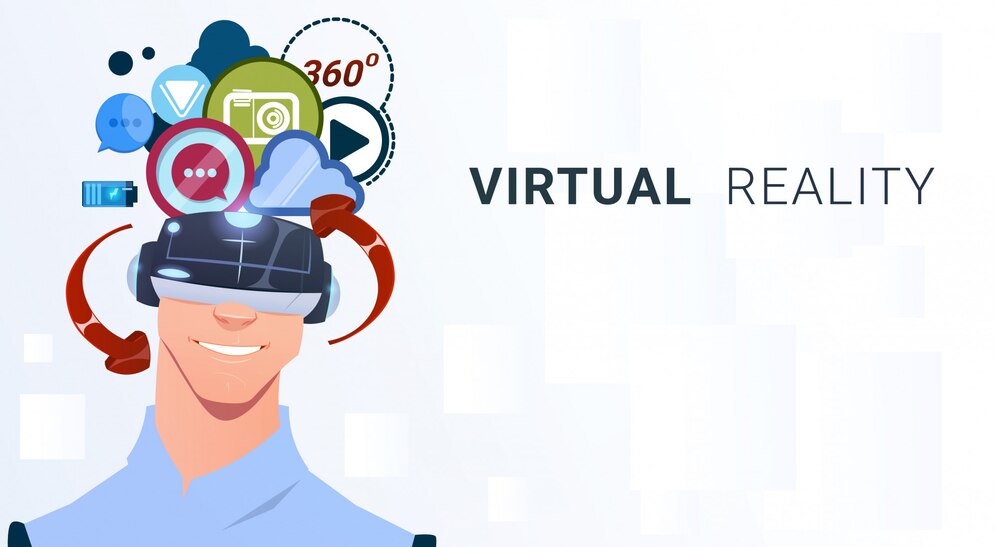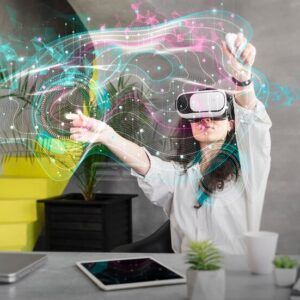Virtual reality (VR) has emerged as a transformative technology, revolutionizing the way we experience and interact with digital environments. In today’s fast-paced technological landscape, understanding the fundamentals of VR is crucial for staying abreast of the latest innovations.

What is Virtual Reality?
At its core, “Virtual Reality” is an immersive technology that transports users into computer-generated environments. The experience goes beyond traditional screen interactions, providing a sense of presence in a simulated reality.
The technology underpinning VR has evolved significantly over the years. Initially, rudimentary headsets have now transformed into sophisticated devices with advanced sensors, high-resolution displays, and responsive tracking mechanisms.
Types of Virtual Reality (VR)
Virtual reality technology comes in various forms, ranging from fully immersive experiences to less intense interactions. Let’s explore these “types of Virtual Reality” in a straightforward manner:
Non-Immersive Virtual Reality
- Involves a partial virtual experience.
- Users engage with the virtual environment without complete immersion.
- Examples include 360-degree videos or basic VR applications that don’t require extensive equipment.
Fully Immersive Virtual Reality
- Offers complete immersion into a digital environment.
- Users often wear headsets and use sensory devices for a comprehensive experience.
- Creates a profound sense of presence, making users feel physically present in the virtual world.
Semi-Immersive Virtual Reality
- Strikes a balance between full immersion and limited interaction with the physical world.
- Commonly used in training simulations or educational settings where users engage with the virtual environment without complete isolation.
Collaborative Virtual Reality
- Involves multiple users interacting in the same virtual space simultaneously.
- Enables collaborative work, meetings, or shared experiences within the virtual realm.
Augmented Reality
- Augmented Reality (AR) overlays digital content onto the real world.
- Enhances the user’s real-world experience by adding computer-generated elements.
- Commonly seen in smartphone apps, smart glasses, or heads-up displays.
Mixed Reality (MR)
- Mixed Reality (MR) combines elements of both virtual and augmented reality.
- Integrates digital content into the real world while allowing interaction.
- Provides a seamless blend of virtual and physical environments.
What is the Need for Virtual Reality?
Virtual Reality addresses several crucial needs in various fields, making it a valuable and transformative technology. Here’s why it’s gaining significance:
Enhanced Learning Experiences
- In education, VR offers immersive and interactive learning environments.
- Students can explore historical events, visit far-off places, or even dissect virtual organisms, enhancing comprehension and engagement.
Medical Training and Therapy
- VR provides a safe and realistic platform for medical professionals to practice surgeries and procedures.
- It’s also used in therapeutic interventions, aiding patients in overcoming fears or managing pain through virtual scenarios.
Simulated Job Training
- Industries use VR to simulate real-world job scenarios for training purposes.
- From aviation to manufacturing, employees can practice and refine their skills in a risk-free virtual environment.
Entertainment and Gaming
- In the entertainment sector, VR elevates gaming experiences to new heights.
- Users can step into the gaming world, interact with characters, and explore fantasy realms, offering an unparalleled level of immersion.
Architectural Visualization
- Architects and designers use VR to create 3D models for immersive walkthroughs.
- This aids in visualizing structures and spaces before they are built, making the design process more effective.
Virtual Travel and Exploration
- VR allows users to virtually travel to destinations they may not have the opportunity to visit physically.
- This has become particularly relevant, given travel restrictions and the desire for novel experiences.
Therapeutic Applications
- Beyond medical therapy, VR is utilized for psychological treatments.
- It helps individuals facing phobias, anxiety, or PTSD by exposing them to controlled virtual environments.
Remote Collaboration
- With the rise of remote work, collaborative VR platforms enable teams to meet and work together in a virtual space, fostering a sense of presence and connection.
How Does Virtual Reality Technology Work?
Virtual Reality (VR) technology relies on sensors and tracking devices to monitor users’ movements, ensuring a seamless integration of their actions into the virtual environment. The combination of visuals and sound further enhances the immersive experience.
Let’s demystify how Virtual Reality technology works in a way that’s easy to understand:
Putting on the Headset
Users wear a special VR headset that looks a bit like oversized goggles. It’s like strapping on a magic window to another world.
Tracking Your Moves
The headset has sensors that keep track of how you move your head. So, when you turn your head in the real world, the virtual world adjusts accordingly.
Creating the Virtual World
Inside the headset, there’s a tiny screen right in front of each eye. This screen displays a 3D digital world or a replication of a real place. It’s like having your own personal movie screen, but it’s all around you.
Adding Some Realism with Sound
To make it more real, there’s spatial audio. Imagine if you hear a sound behind you in the virtual world; you’ll hear it just like you would in real life.
Moving Around
Some systems let you move around in virtual space. Additional sensors or cameras might track your hand movements or even your entire body, letting you interact with the virtual environment.
Fast Processing
To make sure everything runs smoothly, there’s some powerful tech inside the VR setup. High-tech processors and graphics units handle the heavy lifting of creating detailed visuals and responding to your actions in real-time.
Quick Reactions
A crucial part is reducing delays, or what we call latency. Quick reactions to your movements are essential; otherwise, it can feel a bit like a laggy video game.
Adding Touch
For more interaction, there are often handheld controllers. They’re like your virtual hands in the digital world, letting you grab things or point at stuff. Some even have fancy feedback to make it feel more real.
Mixing Real and Virtual
Some setups can blend the virtual world with your real surroundings. This is like a mix of Virtual Reality and Augmented Reality, where digital stuff is added to what you see in the real world.
What Technology Does Virtual Reality Use?
Key components like graphics processing units (GPUs) and high-quality display systems contribute to the realistic rendering of virtual worlds. These technological advancements have been instrumental in pushing the boundaries of VR.
Technology that powers Virtual Reality (VR) in a way that’s easy to understand:
Headset Technology
VR headsets are like the magic goggles of the virtual world. They house tiny, high-resolution displays, creating the visual experience.
Motion Sensors
These sensors track your head movements, ensuring that as you turn or tilt your head, the virtual world responds accordingly. It’s what makes you feel like you’re really there.
Positional Tracking
For more immersive experiences, additional sensors or cameras may track your physical movements in the real world. This allows you to move around and interact with the virtual environment.
Graphics Processing Units (GPUs)
The brains behind the beauty. Powerful GPUs handle the heavy lifting of rendering detailed and realistic graphics in real-time, ensuring the virtual world looks stunning.
Central Processing Units (CPUs)
The CPU is like the conductor of the orchestra, coordinating all the tasks and calculations needed to make the VR experience seamless.
Haptic Feedback
This technology adds a sense of touch. Controllers with haptic feedback can simulate sensations like a gentle breeze or the impact of a virtual object.
Spatial Audio Technology
VR doesn’t just stop at visuals; spatial audio mimics how sounds would behave in the real world. If something is behind you in the virtual space, you’ll hear it from that direction.
Latency Reduction
Low latency is crucial for a smooth experience. It minimizes delays between your actions and the corresponding reactions in the virtual world, preventing motion sickness.
Handheld Controllers
These controllers act as your virtual hands, allowing you to interact with the digital environment. Some even have buttons and sensors for a more hands-on experience.
Augmented Reality (AR) Integration
Some VR setups integrate AR elements, combining the virtual with the real world seamlessly. It’s like having digital objects interact with your physical surroundings.
Networking Technology
For collaborative VR experiences, robust networking technology enables multiple users to interact in the same virtual space.
What Software Does Virtual Reality Use?
A plethora of development platforms and applications facilitate the creation of VR content. From gaming to professional simulations, the software forms the backbone of the virtual reality experience.
Let’s explore the software side of Virtual Reality (VR):
Virtual Reality (VR) Operating Systems
VR devices often run on specialized operating systems tailored for virtual experiences. These systems ensure smooth interactions between the hardware and software components.
Virtual Reality (VR) Platforms
Various platforms host a multitude of VR applications and experiences. Think of them like app stores, but specifically for virtual reality. Examples include Oculus Home, SteamVR, and PlayStation VR.
Virtual Reality (VR) Content Creation Software
For those who want to create their own VR content, there are user-friendly software tools available. These include platforms like Unity and Unreal Engine, enabling users to design and build their virtual worlds.
Virtual Reality (VR) Browsers
Yes, there are browsers specifically designed for VR. They allow users to explore the internet in a more immersive way, often in 3D spaces.
Virtual Reality (VR) Gaming Platforms
Gaming in VR involves specific software platforms where users can access and play virtual reality games. This includes platforms like Oculus Store, SteamVR, and PlayStation VR Store.
Virtual Reality (VR) Social Platforms
As virtual reality becomes more social, there are platforms where users can connect with others in virtual spaces. Examples include VRChat and AltspaceVR.
Virtual Reality (VR) Video and Media Players
Specialized players allow users to watch VR content, including 360-degree videos and virtual reality movies. Apps like Skybox VR Player and DeoVR fall into this category.
Virtual Reality (VR) Productivity Tools
For professional use, there are VR applications designed for productivity, collaboration, and training. Apps like Spatial enable teams to meet in virtual spaces for work or discussions.
Virtual Reality (VR) Antivirus Software
Since VR devices connect to the internet, there are VR-specific antivirus solutions to ensure a secure and safe virtual experience.
Virtual Reality (VR) Firmware Updates
Just like your phone or computer, VR devices receive firmware updates to improve performance, add new features, and fix any bugs.
Features of Virtual Reality (VR)
Virtual Reality, with its array of features, not only entertains but also reshapes how we learn, work, and experience the world. The features of Virtual Reality (VR) in a manner that aligns with your preferences:
Immersive Experience
Virtual Reality (VR) delivers a captivating and immersive experience, transporting users to digital worlds and making them feel present in a way that traditional screens can’t.
Realistic Visuals
Virtual Reality (VR) headsets offer vivid, high-resolution displays that mimic real-world visuals, ensuring a lifelike and detailed experience.
Spatial Audio
With spatial audio, VR provides a sense of directionality in sound, enhancing the overall immersion by making users feel like they’re truly in the center of the action.
Interactivity
Virtual Reality (VR) goes beyond passive viewing; it encourages users to actively engage with the virtual environment, fostering a dynamic and participatory experience.
Head and Hand Tracking
Sophisticated tracking systems follow users’ head and hand movements, ensuring that the virtual world responds seamlessly to their actions.
Simulated Environments
Virtual Reality (VR) can replicate real-world settings or transport users to fantastical realms, catering to diverse experiences from educational simulations to fantasy adventures.
Customization
Personalization is key. Users can customize their virtual spaces, choose avatars, and even shape their surroundings to suit their preferences.
Collaborative Virtual Reality (VR)
Collaborative VR experiences allow multiple users to share the same virtual space, enabling social interactions and shared activities.
Real-time Rendering
The powerful processors in VR systems ensure real-time rendering of graphics, guaranteeing smooth and responsive visuals as users explore the virtual world.
Educational Applications
Virtual Reality (VR) is a game-changer in education, offering interactive and immersive learning experiences that captivate students and enhance understanding.
Healthcare Simulations
In the healthcare field, Virtual Reality (VR) serves as a valuable tool for realistic medical training simulations, providing a safe and controlled environment for practice.
Gaming and Entertainment
Virtual Reality (VR) has revolutionized gaming, providing a level of engagement and immersion that traditional gaming can’t match. It also extends to virtual concerts, events, and cinematic experiences.
Therapeutic Use
Virtual Reality (VR) is increasingly used for therapeutic purposes, aiding individuals in overcoming fears, managing stress, and even undergoing exposure therapy in a virtual setting.
Innovation Across Industries
VR’s versatility extends to various industries, from virtual tourism and architectural visualization to virtual meetings and collaborative work environments.
Applications of Virtual Reality (VR)
The applications of Virtual Reality (VR) in a way that’s accessible and relevant:
Gaming and Entertainment
Virtual Reality (VR) has revolutionized gaming, offering players an immersive experience where they can step into virtual worlds and interact with the environment.
Virtual Tourism
Explore destinations virtually, allowing users to “visit” places they may not be able to travel to physically, providing a unique and engaging tourism experience.
Educational Simulations
Virtual Reality (VR) is used in education to create interactive and immersive simulations, bringing subjects like history, science, and geography to life for students.
Healthcare Training
Medical professionals use Virtual Reality (VR) for realistic training simulations, allowing them to practice surgeries and procedures in a safe and controlled virtual environment.
Therapeutic Interventions
Virtual Reality (VR) is utilized for therapeutic purposes, helping individuals overcome phobias, manage stress, and even undergo exposure therapy in a virtual setting.
Architectural Visualization
Architects and designers use Virtual Reality (VR) to create 3D models of buildings and spaces, offering clients and stakeholders a virtual walkthrough before construction begins.
Employee Training
Various industries use Virtual Reality (VR) for employee training, providing realistic scenarios for practicing skills, from manufacturing processes to customer service.
Virtual Meetings and Collaboration
Virtual Reality (VR) platforms enable users to have virtual meetings and collaborate in shared spaces, providing a sense of presence even when participants are physically distant.
Virtual Concerts and Events
Experience live performances and events in a virtual space, bringing people together for shared entertainment experiences.
Virtual Real Estate Tours
Potential homebuyers can take virtual tours of properties, providing a more immersive and convenient way to explore homes before visiting in person.
Military Training Simulations
The military uses Virtual Reality (VR) for training exercises, creating realistic simulations for soldiers to practice various scenarios and improve their skills.
Museum Exhibits and Cultural Experiences
Virtual Reality (VR) brings museum exhibits to life, allowing users to explore art, history, and cultural artifacts in a virtual setting.
Product Design and Prototyping
Designers use Virtual Reality (VR) to visualize and prototype products, enabling them to make informed decisions and refine designs before manufacturing.
Virtual Job Fairs
Job seekers can attend virtual job fairs, interacting with recruiters and exploring opportunities in a digital environment.
Virtual Reality (VR) Examples
Some real-world examples of Virtual Reality (VR) applications:
Oculus Rift and VR Gaming
Oculus Rift is a popular VR headset, offering a highly immersive gaming experience. Players can step into virtual worlds and interact with the environment using controllers.
Google Earth VR
Explore the world from the comfort of your home with Google Earth VR. Users can virtually travel to any location on Earth and experience it in three dimensions.
VR Classroom Experiences
Educational institutions are adopting VR for virtual field trips and interactive lessons, allowing students to explore historical sites or dive into scientific concepts.
MedicalVR for Healthcare Training
Medical professionals use VR simulations for training, practicing surgeries, and refining their skills in a realistic and risk-free virtual environment.
Beat Saber and VR Fitness
Beat Saber is a rhythm-based VR game that doubles as a fitness activity. Players use lightsabers to slice through blocks, providing an engaging workout.
AltspaceVR Social Platform
AltspaceVR is a virtual social platform where users can meet up with friends, attend events, and engage in shared activities, creating a sense of presence in a virtual space.
VR Concerts with Oculus Venues
Oculus Venues enables users to attend virtual concerts and events, providing an immersive experience that simulates the feeling of being in a live venue.
VR Design with Tilt Brush
Tilt Brush allows artists and designers to create 3D paintings in virtual space, providing a unique and intuitive way to express creativity.
VR Real Estate Tours
Real estate agents use VR to offer virtual property tours, allowing potential buyers to explore homes remotely in a realistic and immersive manner.
VR Therapy for PTSD
VR therapy is used to treat post-traumatic stress disorder (PTSD) by exposing individuals to controlled and virtual scenarios to address and manage trauma.
IKEA VR Kitchen Planner
IKEA offers a VR experience where users can design and visualize their kitchen spaces, helping them make informed decisions before purchasing.
VR Training for Flight Simulators
Pilots use VR for flight simulation training, offering a realistic and immersive environment to practice various flight scenarios.
Moss VR for Storytelling
Moss is a VR game that incorporates storytelling in a unique way, letting players guide a small mouse through a captivating and immersive narrative.
VR Meditation and Relaxation Apps
Apps like Guided Meditation VR provide virtual environments for relaxation and meditation, offering a tranquil escape from the real world.
Advantages and Disadvantages of VR
While VR enhances experiences and training simulations, concerns about potential health drawbacks have arisen. Striking a balance between the advantages and disadvantages is crucial for responsible adoption.
Advantages of Virtual Reality (VR)
Immersive Experiences
VR provides users with immersive and lifelike experiences, creating a sense of presence in a virtual environment.
Enhanced Learning
In education, VR offers interactive and engaging learning experiences, making complex subjects more accessible and enjoyable.
Training Simulations
Industries use VR for realistic training simulations, allowing professionals to practice skills in a safe and controlled virtual setting.
Innovative Healthcare Solutions
VR aids in medical training, therapeutic interventions, and pain management, providing innovative solutions in healthcare.
Virtual Tourism
Users can explore different destinations virtually, offering a unique and accessible way to “visit” places from the comfort of their homes.
Design and Prototyping
VR assists designers in visualizing and refining products before manufacturing, streamlining the prototyping process.
Entertainment Revolution
VR has transformed gaming and entertainment, offering new levels of immersion and engagement for users.
Remote Collaboration
Virtual reality enables remote collaboration, allowing individuals to meet and work together in shared virtual spaces.
Accessibility
VR makes experiences accessible to individuals with physical limitations, providing a platform for inclusive interactions.
Disadvantages of Virtual Reality (VR)
Cost of Entry
High-quality VR equipment can be expensive, limiting widespread adoption and accessibility.
Motion Sickness
Some users may experience motion sickness or discomfort, particularly if there is a mismatch between visual and physical movements.
Isolation Concerns
Extended use of VR may lead to social isolation as users immerse themselves in virtual worlds, potentially neglecting real-world interactions.
Technical Limitations
VR technology is continually evolving, and current systems may have technical limitations such as lower resolution or restricted field of view.
Health and Safety
Prolonged use of VR may have health implications, including eye strain, headaches, or discomfort. Ensuring safe and responsible use is crucial.
Content Quality
The quality of VR content can vary, and not all experiences may meet user expectations, impacting the overall perception of the technology.
Dependency Concerns
Overreliance on virtual experiences may lead to a detachment from reality, raising concerns about the balance between the virtual and real worlds.
Privacy Issues
VR raises privacy concerns, especially if users are unaware of data collection or if personal information is at risk within virtual environments.
What is the Difference Between VR and AR?
Distinguishing virtual reality from augmented reality lies in the level of immersion. VR creates a fully digital environment, while AR overlays digital content onto the real world, blending the virtual and physical seamlessly.
Key differences are as:
Immersiveness
VR provides a fully immersive experience, blocking out the real world entirely, while AR enhances the real world with additional digital elements.
User Interaction
In VR, interaction is primarily within the virtual environment. In AR, users interact with both the real and virtual elements simultaneously.
Application Focus
VR is often applied in scenarios where a completely synthetic environment is desired, like gaming. AR is used to augment real-world experiences, adding digital information to the user’s surroundings.
Device Requirements
VR requires dedicated headsets that fully cover the user’s field of vision. AR can be experienced through various devices, including everyday smartphones.
Isolation vs. Integration
VR isolates users from the real world, creating a standalone virtual experience. AR integrates digital content into the real world, allowing users to engage with both simultaneously.
Future of Virtual Reality (VR)
As technology continues to advance, the future of VR holds promises of even more realistic experiences. Anticipated advancements include improved hardware, enhanced graphics, and increased accessibility, paving the way for widespread adoption.

Evolving trends in the future of virtual reality:
Improved Hardware
Expect advancements in VR hardware, with lighter, more comfortable headsets, and enhanced display technologies offering higher resolutions and wider fields of view.
Wireless Connectivity
The future holds the promise of wireless VR experiences, reducing the constraints of cables and providing users with more freedom of movement.
Gesture and Voice Controls
Gesture and voice controls are likely to become more sophisticated, allowing users to interact with virtual environments more intuitively.
Enhanced Realism
Advancements in graphics and simulation technologies will contribute to even more realistic and immersive virtual experiences, blurring the lines between the virtual and real worlds.
Social VR Experiences
The future will see an increased focus on social VR, allowing users to connect, collaborate, and share experiences in virtual spaces, fostering a sense of presence and community.
Integration with AI
Artificial Intelligence (AI) integration in VR experiences will enhance interactivity, allowing virtual environments to adapt and respond intelligently to user behavior, creating more dynamic and personalized experiences.
Expanded Applications
VR will find broader applications across various industries, including education, healthcare, remote work, and virtual tourism, transforming how we learn, work, and engage with the world.
Affordability and Accessibility
As technology advances, the cost of VR hardware is likely to decrease, making it more accessible to a broader audience and driving increased adoption.
Mixed Reality Integration
The lines between Virtual Reality (VR) and Augmented Reality (AR) may blur further, giving rise to more Mixed Reality (MR) experiences that seamlessly combine elements of both technologies.
Health and Wellness Integration
VR may play a significant role in health and wellness, with applications ranging from VR fitness routines to therapeutic interventions for mental health.
Educational Revolution
VR is poised to revolutionize education, offering immersive and interactive learning experiences that go beyond traditional classroom settings.
Entertainment Innovation
The entertainment industry will continue to innovate with VR, offering new and engaging content, from virtual concerts and events to interactive storytelling experiences.
Global Collaboration
VR may facilitate global collaboration by enabling individuals from different parts of the world to work together in virtual spaces, transcending geographical boundaries.
Exploring Virtual Reality Experiences Across the United States
From the glitz and glamour of Las Vegas to the cultural hub of San Francisco, and the vibrant landscapes of New Jersey, VR is leaving its mark on cities across the United States.
Virtual Reality Experience in Las Vegas
Las Vegas, renowned for its entertainment and innovation, offers a unique VR landscape. Dive into virtual worlds that mirror the city’s extravagant shows and lively atmosphere. From virtual casinos to immersive experiences that transport you to the iconic Strip, Las Vegas is at the forefront of blending entertainment and cutting-edge technology.
Virtual Reality in San Francisco
In the heart of tech innovation, San Francisco boasts a diverse array of VR experiences. Explore the city’s rich history or embark on futuristic adventures in Silicon Valley-inspired virtual landscapes. With VR cafes and interactive exhibits, San Francisco is a haven for those eager to embrace the intersection of technology and culture.
Virtual Reality Adventures in New Jersey
New Jersey, often overshadowed by its neighboring metropolises, is carving its niche in the VR scene. Experience the charm of local virtual attractions, from interactive museums to unique VR gaming hubs. New Jersey proves that you don’t need a colossal skyline to offer captivating virtual adventures.
Virtual Reality Thrills in San Diego
San Diego, with its sunny beaches and laid-back vibe, introduces VR experiences that complement its coastal charm. Dive into virtual marine worlds, explore historical landmarks, or engage in adrenaline-pumping VR sports. San Diego’s VR offerings capture the essence of a city that seamlessly blends leisure and innovation.
Virtual Reality Escapades in Orlando
Orlando, known for its theme parks and family-friendly attractions, extends its magic to the virtual realm. Enter fantastical VR worlds that mirror the enchantment of Disney and Universal Studios. Orlando’s VR experiences are a testament to the city’s commitment to creating magical moments, both real and virtual.
Virtual Reality Journeys in Austin
Austin’s vibrant music scene and eclectic culture extend into the virtual landscape. Immerse yourself in live VR concerts or explore virtual replicas of the city’s iconic landmarks. Austin’s VR scene reflects its status as a cultural melting pot, offering experiences that resonate with the city’s artistic spirit.
Virtual Reality Wonders in Los Angeles
Los Angeles, the entertainment capital, embraces VR as an extension of its creative prowess. Step into virtual movie sets, attend VR film premieres, or explore the city’s diverse neighborhoods through immersive experiences. Los Angeles seamlessly integrates the magic of Hollywood with the technological wonders of VR.
Virtual Reality Exploration in Chicago
Chicago’s skyline serves as a backdrop to a growing VR community. Engage in virtual art exhibits, architectural tours, or dive into the city’s rich history through immersive storytelling. Chicago’s VR experiences capture the essence of a city that balances tradition with modern innovation.
Virtual Reality Adventures in Dallas
Dallas, a city known for its Southern hospitality, extends a warm welcome to VR enthusiasts. Immerse yourself in virtual Texan landscapes, experience rodeos from the comfort of your headset, or explore the city’s modern skyline through VR architecture tours. Dallas combines its rich heritage with the excitement of cutting-edge technology.
Virtual Reality Excitement in Atlanta
Atlanta, a hub of culture and commerce, embraces VR as a dynamic form of expression. Engage in virtual concerts featuring the city’s diverse music scene or embark on VR tours that showcase Atlanta’s historical significance. Atlanta’s VR experiences reflect the city’s commitment to celebrating its past while embracing the future.
Virtual Reality Extravaganza in Houston
Houston, a city synonymous with space exploration, ventures into the virtual frontier. Experience simulated space missions or explore futuristic VR innovations in the heart of Texas. Houston’s VR offerings echo the city’s spirit of exploration and discovery.
Conclusion
In conclusion, virtual reality stands at the forefront of technological innovation, offering immersive experiences across various domains. From gaming to healthcare, its applications are diverse and continually expanding. As we look towards the future, the evolution of virtual reality promises exciting possibilities and transformative changes in how we interact with digital environments.
Thank you for finding value in this blog. Feel free to visit TheGreatInfo.com regularly to stay updated on the latest technology trends. Wishing you an excellent day!
Frequently Asked Questions
Q. Is virtual reality only for gaming purposes?
No, virtual reality finds applications in healthcare, education, training simulations, and entertainment beyond gaming.
Q. What are the potential health concerns associated with virtual reality?
Prolonged use of virtual reality may lead to discomfort, motion sickness, and eye strain, but advancements are being made to address these issues.
Q. How does augmented reality differ from virtual reality?
Augmented reality overlays digital content onto the real world, while virtual reality creates a fully immersive digital environment.
Q. What is the future outlook for virtual reality technology?
The future of virtual reality holds promises of improved hardware, enhanced graphics, and increased accessibility, leading to widespread adoption.
Q. Can virtual reality be used in educational settings?
Yes, virtual reality has applications in education, providing immersive and interactive learning experiences.





